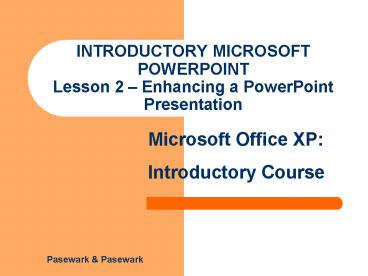INTRODUCTORY MICROSOFT POWERPOINT Lesson 2 - PowerPoint PPT Presentation
1 / 15
Title:
INTRODUCTORY MICROSOFT POWERPOINT Lesson 2
Description:
... as the font, size, color, style, alignment, spacing, and background. ... Layouts include placeholders for text, columns, bulleted lists, clip art, tables, ... – PowerPoint PPT presentation
Number of Views:358
Avg rating:3.0/5.0
Title: INTRODUCTORY MICROSOFT POWERPOINT Lesson 2
1
INTRODUCTORY MICROSOFT POWERPOINTLesson 2
Enhancing a PowerPoint Presentation
2
Objectives
- Create a new presentation.
- Format slides.
- Work with text on slides.
- Use the slide master.
- Add multimedia to slides.
- Add a slide.
- Add a header or footer.
- Use slide transitions.
- Format a single slide.
3
Terms Used in This Lesson
- Animate
- AutoContent Wizard
- Design template
- Effects options
- Hyperlink
- Motion path
- Placeholder
- Show Advanced Timeline
- Slide master
- Slide transitions
4
Creating a Presentation
- When you start PowerPoint, the task pane displays
four choices - Open a presentation
- New
- Blank Presentation - create a presentation from
scratch - From Design Template templates are already
formatted with colors, fonts, and layouts - From AutoContent Wizard - guides you through a
series of questions about the type of
presentation, output options, presentation style,
and presentation options - New from existing presentation
- New from template
5
Applying a Design Template
- Design templates are pre-designed graphic styles
that you can apply to your slides. You can change
the color scheme, font, formatting, and layout of
your slides in a design template to create a
different look.
6
Format a Single Slide
- You can use a design template to change the
appearance of a single slide without changing the
rest of the slides in the presentation.
7
Use the Slide Master
- The slide master controls the formatting for all
the slides in the presentation. - You can use the slide master to change such items
as the font, size, color, style, alignment,
spacing, and background. - Changing the slide master affects the appearance
of all of the slides and gives them a consistent
look. - You can add headers and footers to slides and
also place an object, such as a logo or graphic,
on every slide by placing the object on the slide
master.
8
Check Spelling and Style
- Automatic spell checking identifies misspellings
and words that are not in its dictionary by
underlining them with a wavy red line immediately
after you key them. - PowerPoint determines if your presentation
conforms to the standards of good style. For
instance, title text size should be at least 36
points and the number of bullets on a slide
should not exceed six. It will also alert you to
problems with visual clarity such as appropriate
font usage and legibility, and inconsistent
capitalization, and end punctuation.
9
Adding a Slide
- You can add a slide to a presentation by clicking
the New Slide button on the toolbar. In the
Normal view, PowerPoint places the new slide
after the currently displayed slide. - Another way to add a slide is to copy it from
another presentation. Choose Slides from Files
from the Insert menu. Locate the presentation
from which you want to copy a slide and click
Display. Select the slide you want to copy and
click Insert. PowerPoint inserts the slide after
the one displayed on the screen.
10
Formatting Slides
- To change the layout of text or graphics on
slides, you can use the programs preset layouts.
- PowerPoint includes 27 AutoLayouts you can choose
from to create a new slide or change the layout
of an existing slide. - Layouts include placeholders for text, columns,
bulleted lists, clip art, tables, organization
charts, objects, graphs, and media clips.
11
Using Multimedia
- Working with Clip Art
- Custom Animation
- Insert a Hyperlink
- Adding a Sound
12
Adding a Heading or Footer
- You can add a header of footer on the Slide
Master or by selecting Header and Footer from the
View menu. - The AutoContent Wizard automatically creates a
footer during the setup process. - You can add the date and time, slide number, and
any text you want to the footer of the slide. - When you click the Notes and Handouts tab you
also have the option of creating a header.
13
Use Slide Transitions
- Slide Transitions determine how one slide is
moved from the screen and how the next one
appears. - To set the transitions between slides, choose
Slide Transition from the Slide Show menu and
make your choices in the Slide Transition dialog
box that appears in the task pane.
14
Summary
- You can use PowerPoint to create a new
presentation and apply design templates, color
schemes, slide animations, and text. - You can change a presentation in PowerPoint by
applying slide layouts, adding clip art, and
custom animation. - You can add notes to a slide in PowerPoint.
15
Summary
- You can change text appearance and bullet
appearance in PowerPoint. - You can add a slide to an existing PowerPoint
presentation. - You can insert a hyperlink or a header or footer
in a PowerPoint presentation.































